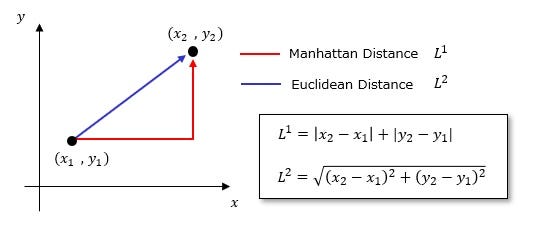Distance Metrics and Variants in KNN#
The choice of distance metric greatly influences how KNN defines “neighborhoods” and classifies points.
It depends on the nature of the data and the problem context.
Common Distance Metrics#
1. Euclidean Distance (L2 Norm)#
Detail |
Description |
|---|---|
Description |
Measures the straight-line distance between two points in space. |
Use When |
Features are continuous and measured on the same scale. Differences in magnitude are meaningful (e.g., height, weight). |
Caution |
Highly sensitive to outliers and varying feature scales — always normalize or standardize data before use. |
Formula |
$\(d(\mathbf{x}, \mathbf{y}) = \sqrt{\sum_{i=1}^{n} (x_i - y_i)^2}\)$ |
2. Manhattan (City Block) Distance (L1 Norm)#
Detail |
Description |
|---|---|
Description |
Measures the distance by summing absolute differences along each dimension (like moving along a grid). |
Use When |
Movement is restricted to orthogonal directions (e.g., city blocks). Features contribute independently to distance. Works better than Euclidean for high-dimensional data as it reduces the impact of large single-feature deviations. |
Caution |
Less sensitive to outliers than Euclidean, but still requires feature scaling for optimal performance. |
Formula |
$$d(\mathbf{x}, \mathbf{y}) = \sum_{i=1}^{n} |

3. Hamming Distance#
Detail |
Description |
|---|---|
Description |
Counts the number of features where two samples differ (mismatches between attribute values). |
Use When |
Data is categorical or binary (e.g., yes/no, text encodings, DNA sequences). |
Caution |
Only works for discrete or categorical features. It gives a binary measure (different or not different) for each feature. |
Formula |
$\(d(\mathbf{x}, \mathbf{y}) = \sum_{i=1}^{n} \mathbb{I}(x_i \neq y_i)\)\( (Where \)\mathbb{I}(\cdot)$ is the indicator function.) |
4. Cosine Similarity#
Detail |
Description |
|---|---|
Description |
Measures the cosine of the angle between two vectors — focuses purely on orientation, not magnitude or size. |
Use When |
Direction matters more than size (e.g., text analysis, where document length shouldn’t bias similarity). Common in recommender systems. |
Caution |
Returns similarity (1 is close, 0 is far) rather than distance. It is often converted to a distance metric as: \(d = 1 - \text{similarity}\). |
Formula |
$\(\text{Similarity}(\mathbf{x}, \mathbf{y}) = \frac{\mathbf{x} \cdot \mathbf{y}}{|\mathbf{x}| |\mathbf{y}|}\)$ |
Weighted KNN#
So far, we have talked about standard KNN, where every one of the k neighbors has an equal vote. Now, we will introduce Weighted K-Nearest Neighbors changes this by giving more weight to the neighbors that are closer to the new data point.
Why? According to Weighted KNN, closer neighbors have a stronger influence on the prediction.
Mathematically, each neighbor is weighted by:
Where:
This means points closer to the query point contribute more to the prediction than distant ones.
In scikit-learn, you can enable this using:
KNeighborsClassifier(n_neighbors=5, weights='distance')
Key Points to remember:
Standard KNN treats all neighbors equally (weights=’uniform’).
Weighted KNN emphasizes closer neighbors, making the classifier more robust to noise.
Works best when your features are continuous numeric values (like Iris measurements).-
Section 6: Ethics and Responsible ML#
Why Ethics Matter#
Machine Learning models can impact real people — from job applications to healthcare decisions. Therefore, fairness and transparency are essential.
Bias: When data reflects historical prejudice.
Fairness: Ensure models treat groups equally.
Transparency: Explain how the model makes decisions.
Privacy: Respect individuals’ personal data.
Example: A hiring model should not unfairly prefer one gender or race.
Section 7: Hands-on Practice#
Task: Identify the ML Type#
Predicting house prices → ?
Grouping customers → ?
Teaching a robot to play chess → ?
Section 8: Reflection Questions#
What distinguishes Machine Learning from traditional programming?
Why is testing important after training a model?
How can bias in ML models be reduced?
Summary: What We Learned#
In this chapter, we walked through the complete Machine Learning workflow — from data to deployment-ready model (conceptually).
We covered:
Understanding the dataset – explored real data (Iris flower dataset).
Defining features and labels – identified what to predict and what to use for prediction.
Training a model – taught a KNN to learn from data.
Evaluating performance – measured accuracy on unseen test data.
Visualizing data – saw how features relate and form clusters.
Key takeaway:
Machine Learning is about teaching computers to learn from data and improve over time — not just follow fixed rules.
ML enables systems to learn from data automatically.
Three main types: Supervised, Unsupervised, and Reinforcement.
Workflow: Data → Model → Evaluation → Deployment.
Ethical ML ensures fairness, transparency, and accountability.